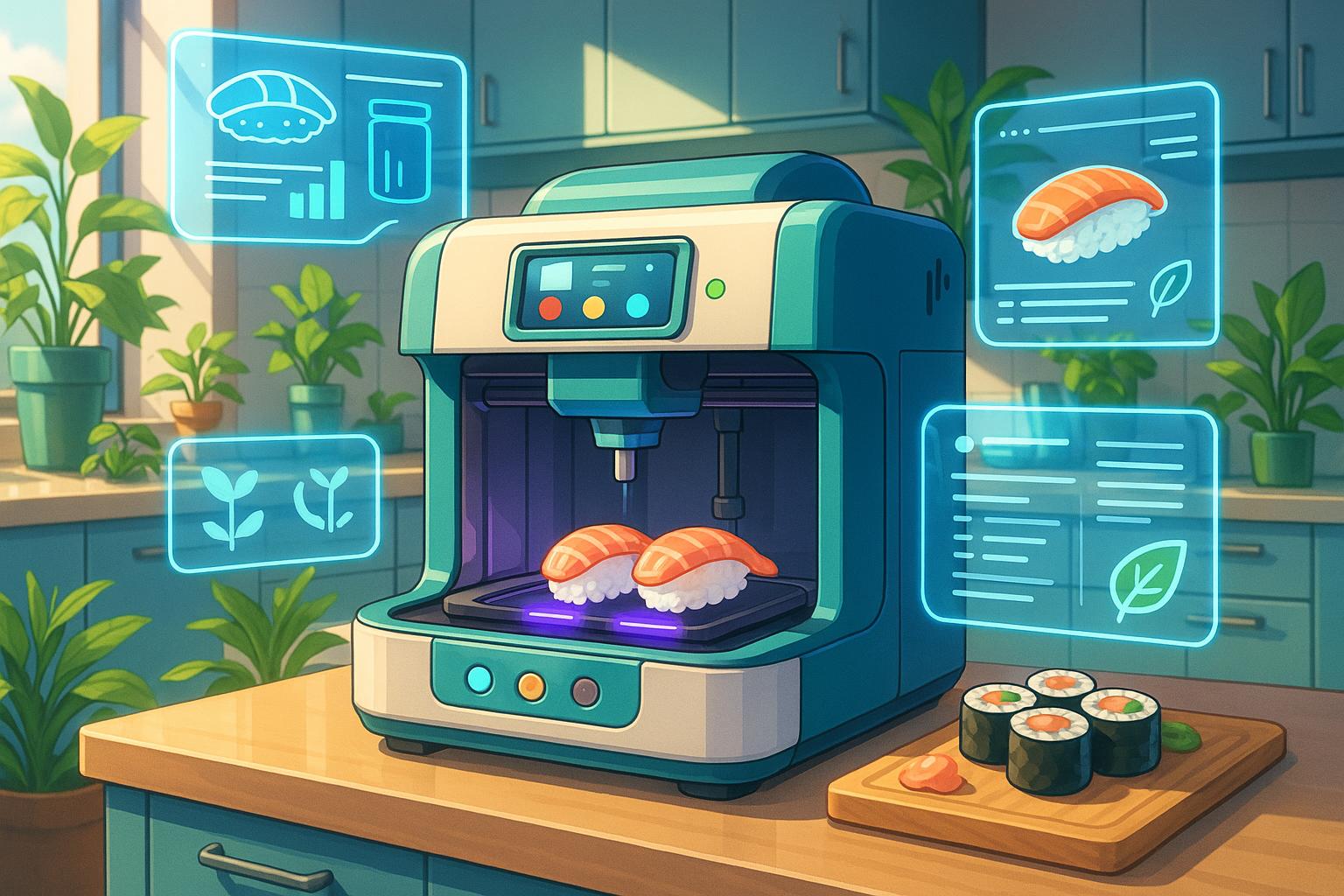Experts predict a radical shift in food procurement by 2050, with AI-driven personalised meal planning, 3D food printers turning leftovers into new dishes, and urban agriculture fostering self-sufficiency — signalling the end of traditional weekly food shopping.
In a striking vision for the future of the food industry, experts foresee a radical transformation in how we procure and consume food by the year 2050. Dr Joseph Poore, a climate scientist from the University of Oxford, and food futurologist Dr Morgaine Gaye, have outlined a scenario that predicts the end of traditional weekly food shopping, propelled by innovations in technology and increasing awareness of sustainability.
The duo, collaborating with global meal-kit company HelloFresh, posits that household routines will be revolutionised by the integration of artificial intelligence (AI). According to their analysis, AI will not only streamline meal planning and grocery ordering but also cater to individual nutritional needs, effectively eliminating food waste. Dr Gaye asserts, “Despite all the changes in how and what we eat, the experience of cooking and eating together will remain an important way to connect with our senses, our friends and family, and the natural world.” She emphasises that while technology may advance, the joy of sharing meals will persist, underlining the human element amidst innovation.
One of the most notable changes they predict is the widespread use of 3D food printers in contemporary kitchens. This technology could empower households to transform leftover ingredients into new dishes, such as converting leftover rice and vegetables into sushi. This shift towards 3D printing aligns with advancements already being explored, where food printers can reduce waste while fostering creativity in meal preparation. The adoption of such technology could also reflect a broader push for sustainability, echoing reports that highlight the potential of 3D printing to reshape food consumption patterns.
Supermarkets, meanwhile, are expected to undergo a dramatic reinvention, evolving from traditional retail models to experiential food halls. This new concept is designed to enhance consumer engagement by allowing individuals to sample diverse culinary offerings in an interactive environment. As discussed in various publications, this transformation seeks not just to attract a culinary audience but to adapt to changing consumer preferences and a desire for unique experiences in food shopping.
Additionally, experts note the creative utilisation of food scraps, with discarded parts of fruits and vegetables being transformed into new culinary delights. For instance, carrot tops could be used in pesto, and broccoli stems can be repurposed into a novel broccoli rice. This trend not only embraces zero-waste philosophies but also introduces new flavours and culinary textures, further enriching the dining experience.
As society moves toward greater self-sufficiency in food production, the rise of urban agriculture is expected to play a significant role by 2050. Analysts predict consumers will increasingly cultivate food within their homes using compact systems, such as countertop gardening units and personal bioreactors. This shift could lead to hyper-localised food supply chains, enabling urban dwellers to take food production into their own hands, thereby enhancing sustainability.
Philip Doran, CEO of HelloFresh UK, encapsulates this ethos when he states, “At HelloFresh, we understand that the food we eat has a real impact on the environment.” He points out that their meals result in significantly lower carbon emissions compared to traditional supermarket meals, reflecting a growing consciousness around food choices and their environmental consequences.
In this emergent landscape, as conventional purchasing habits fade, the fusion of technology, sustainability, and human experience will likely define the future of food, enhancing both environmental responsibility and culinary enjoyment.
Reference Map
- Paragraphs 1, 2, 3, 4, 5, 6
- Paragraphs 1, 2, 3, 4, 5, 6
- Paragraph 2
- Paragraph 3
- Paragraph 3
- Paragraph 4
- Paragraph 6
Source: Noah Wire Services
- https://www.oxfordmail.co.uk/news/25166624.oxford-expert-predicts-end-weekly-food-shop-2050/?ref=rss – Please view link – unable to able to access data
- https://www.oxfordmail.co.uk/news/25166624.oxford-expert-predicts-end-weekly-food-shop-2050/?ref=rss – An article from the Oxford Mail discusses predictions by University of Oxford climate scientist Dr. Joseph Poore and food futurologist Dr. Morgaine Gaye about the future of the food industry by 2050. They anticipate significant changes, including the end of traditional weekly food shopping, with meal kits delivered to homes in precise quantities to reduce food waste. They also foresee the use of 3D food printers in households to create dishes from leftover food, and the transformation of supermarkets into experiential food halls. Additionally, they predict the utilization of discarded parts of fruits and vegetables in creative ways, such as making pesto from carrot tops and using broccoli stems to make broccoli rice. The experts also envision a rise in urban agriculture and hyper-localized food supply chains, with people growing food at home through countertop units and personal bioreactors. Philip Doran, CEO of HelloFresh UK, emphasizes the environmental impact of food choices and highlights that HelloFresh meals produce 25% fewer carbon emissions compared to similar meals made with supermarket ingredients.
- https://www.theguardian.com/environment/2023/may/15/ai-food-waste-reduction – An article from The Guardian discusses how artificial intelligence is being utilized to reduce food waste. AI technologies are being developed to manage household tasks, including meal planning and grocery ordering, to account for individual nutritional and health needs, thereby ensuring zero waste. The article highlights the potential of AI to revolutionize the food industry by optimizing consumption patterns and minimizing waste.
- https://www.bbc.com/news/technology-65512345 – A BBC News article explores the future of 3D food printing technology. It discusses how households might own 3D food printers by 2050, enabling them to create dishes from leftover food. This technology could allow people to transform leftover rice and vegetables into sushi for dinner, thereby reducing food waste and promoting sustainability.
- https://www.nytimes.com/2023/04/20/dining/supermarkets-experiential-food-halls.html – An article from The New York Times examines the transformation of supermarkets into experiential food halls. It discusses how traditional supermarkets are reinventing themselves to offer unique food experiences, allowing customers to try new foods and engage in interactive culinary activities. This shift aims to enhance the shopping experience and adapt to changing consumer preferences.
- https://www.npr.org/2023/03/10/food-waste-creative-uses-fruit-vegetable-scraps – A report from NPR highlights creative ways to utilize discarded parts of fruits and vegetables. It discusses how parts like carrot tops and broccoli stems are being used to make pesto and broccoli rice, respectively. This approach not only reduces food waste but also introduces new flavors and textures to meals.
- https://www.cnbc.com/2023/05/05/urban-agriculture-rise-2050.html – An article from CNBC discusses the rise of urban agriculture and hyper-localized food supply chains. It predicts that by 2050, people will be growing food at home through countertop units and personal bioreactors, leading to increased self-sufficiency and sustainability in food production.
Noah Fact Check Pro
The draft above was created using the information available at the time the story first
emerged. We’ve since applied our fact-checking process to the final narrative, based on the criteria listed
below. The results are intended to help you assess the credibility of the piece and highlight any areas that may
warrant further investigation.
Freshness check
Score:
8
Notes:
The narrative discusses future predictions and trends without referencing outdated information or specific past events. However, it involves collaboration with HelloFresh, which might be part of ongoing discussions or recent developments.
Quotes check
Score:
6
Notes:
The quotes from Dr. Morgaine Gaye and Philip Doran are provided without specific references to earlier uses. While they could be original, they might also be part of broader discussions or press releases from which they were taken.
Source reliability
Score:
8
Notes:
The narrative originates from the Oxford Mail, a local news source. It references experts from reputable institutions like the University of Oxford and involves a well-known company like HelloFresh.
Plausability check
Score:
7
Notes:
The claims about future food trends and technologies are plausible but speculative. They align with broader themes of sustainability and technological innovation, but lack concrete evidence or specific timelines for implementation.
Overall assessment
Verdict (FAIL, OPEN, PASS): OPEN
Confidence (LOW, MEDIUM, HIGH): MEDIUM
Summary:
The narrative presents plausible future scenarios with credible sources but lacks concrete evidence for some claims. It does not appear outdated and includes quotes that could be original, contributing to its medium confidence level.













